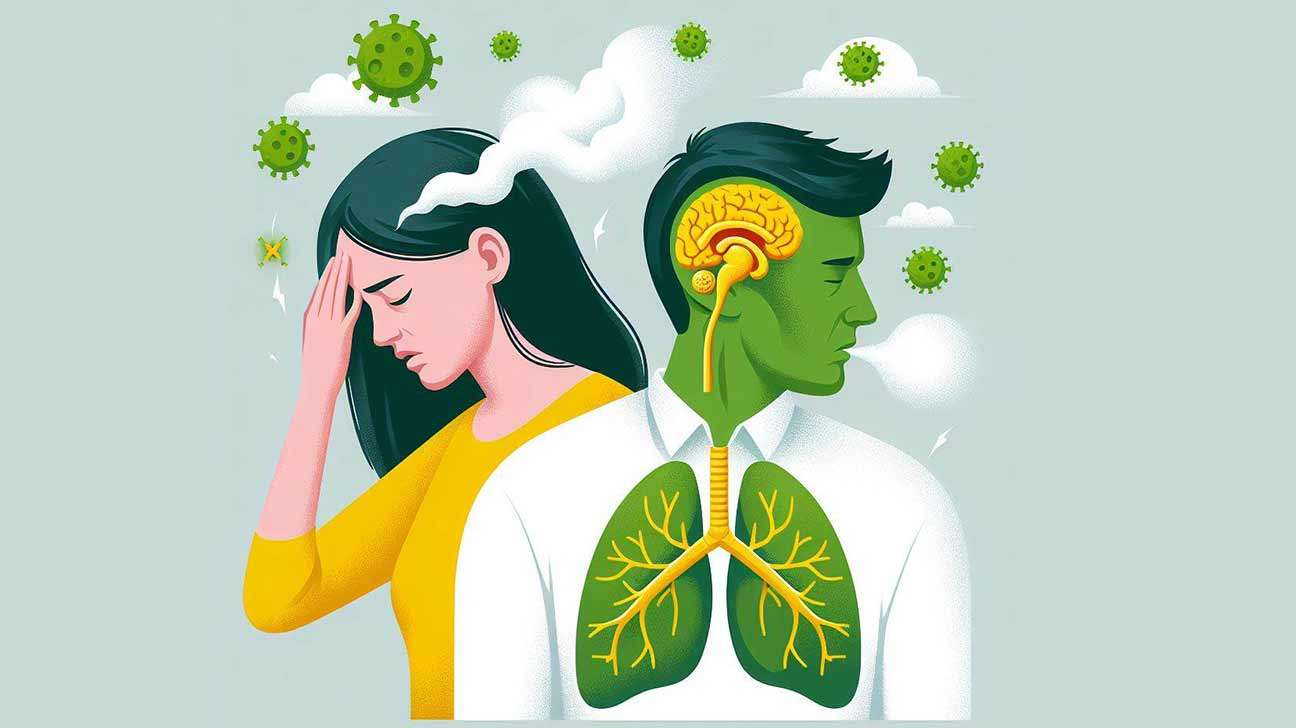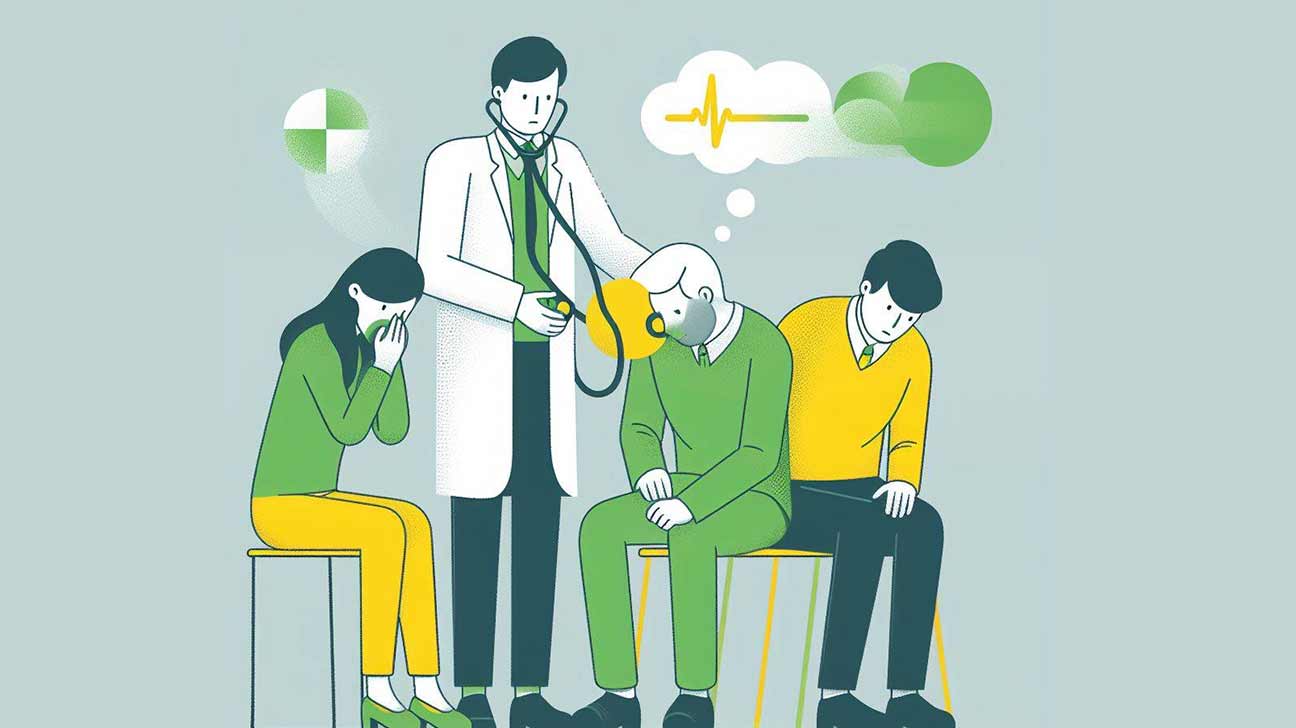
Detail Information of IPF
Idiopathic Pulmonary Fibrosis (IPF) is a progressive lung disease characterized by scarring and stiffening of the lung tissue. Symptoms include shortness of breath, a persistent dry cough, and fatigue, with a prognosis of three to five years after diagnosis.
Understanding IPF is critical for those affected by this challenging condition. The disease progressively worsens, making it difficult for patients to breathe. IPF falls under the larger category of interstitial lung diseases, which affect the tissue and space around the air sacs of the lungs.
The term ‘idiopathic’ suggests that the cause of the pulmonary fibrosis is unknown. Despite ongoing research, the exact mechanisms behind IPF remain a mystery, complicating the development of targeted therapies. Early detection is pivotal, yet the symptoms are often dismissed as signs of aging or less serious health issues. Treatments focus on managing symptoms and slowing progression, but there is no known cure. Thus, education and support for those living with IPF, and their caregivers are immensely important.
Diagnosis of IPF
Identifying Idiopathic Pulmonary Fibrosis (IPF) becomes crucial to managing this challenging condition. A detailed diagnostic process helps ensure treatment can begin as early as possible. Explore the steps doctors take to diagnose IPF.
Physical Examination
The first step in IPF diagnosis is a thorough physical exam. Your doctor will listen to your lungs with a stethoscope. They listen for a specific type of crackling sound known as “Velcro” crackles due to their resemblance to Velcro being pulled apart. They will also look for signs of finger clubbing, where fingertips widen and become rounder.
Imaging Tests
High-resolution imaging tests are vital for seeing the lungs’ condition. The most common imaging test is a high-resolution computed tomography (HRCT) scan. This scan shows detailed images of the lungs, which can reveal the patterns of fibrosis characteristic of IPF. Sometimes, chest X-rays are used in initial assessments.
Lung Function Tests
To understand how well the lungs work, doctors conduct lung function tests. These include:
- Spirometry: Measures the amount and speed of air you can inhale and exhale.
- Diffusion capacity: Assesses how well oxygen and carbon dioxide exchange between your blood and lungs.
- Pulmonary function test: Reveals the overall performance of the lungs.
Decreased lung function can be a sign of IPF, as scarring affects the lungs’ capacity to move and process air.
Causes of IPF
Idiopathic Pulmonary Fibrosis (IPF) arises from a complex interplay of factors. Untangling these causes helps us understand this baffling condition. The following sections delve into the specifics of what triggers IPF.
Genetic Factors
Genes play a crucial role in the development of IPF. Recent studies suggest a heritable aspect to the disease.
- A particular group of genes, called surfactant proteins, are often linked to IPF.
- Mutations in the TERT or TERC genes can also increase IPF risk.
- Genetic counseling may be beneficial for families with a history of IPF.
Environmental Exposures
IPF can be sparked by environmental factors. Long-term exposure to certain substances is harmful to the lungs.
| Type of Exposure | Examples |
|---|---|
| Occupational | Metal dust, wood dust, farming chemicals |
| Environmental | Air pollution, indoor mold, tobacco smoke |
Other Risk Factors
Several other elements contribute to the likelihood of developing IPF.
- Age: IPF is more common in adults over 50.
- Sex: Men are at a higher risk than women.
- Lifestyle: Smoking significantly increases the risk.
Medical history, such as viral infections and acid reflux, can also play a role.
Treatment

Idiopathic Pulmonary Fibrosis (IPF) requires a targeted approach to manage its symptoms and progression. Effective treatments can improve quality of life and breathing for those affected by this condition. Understanding the options available is the first step in taking control of IPF.
Medication
Antifibrotic agents are the primary medications used to treat IPF. These drugs slow down the damage to lung tissue and can help maintain lung function. The use of anti-inflammatory drugs might be prescribed depending on individual circumstances. Regular consultation with a healthcare provider ensures optimal medication strategies for each patient.
| Medication | Purpose | Possible Side Effects |
|---|---|---|
| Pirfenidone | Slows disease progression | Nausea, Rash, Photosensitivity |
| Nintedanib | Slows decline in lung function | Diarrhea, Liver enzyme elevation |
Oxygen Therapy
IPF often leads to low oxygen levels in the blood. Oxygen therapy helps maintain the required oxygen to the body. Portable or stationary oxygen tanks provide flexibility for an active lifestyle. Proper use of oxygen can reduce fatigue and improve sleep and cognition.
- Portable Oxygen Concentrators
- Stationary Oxygen Systems
- Oxygen Cylinders for backup
Pulmonary Rehabilitation
Pulmonary rehabilitation combines exercise training, nutritional advice, and educational seminars to strengthen lung function. Tailored exercise routines improve endurance and ease breathlessness. Rehabilitation teams also provide emotional support and coping strategies. The goal is to promote an active and fulfilling life despite IPF.
- Assessment by a pulmonary specialist
- Exercise tailored to personal capabilities
- Educational resources on IPF
Management
Managing Idiopathic Pulmonary Fibrosis (IPF) is a challenge that requires a comprehensive approach. It involves making lifestyle changes, receiving supportive care, and considering surgical options when necessary. Let’s explore these strategies to help patients maintain their quality of life.
Lifestyle Changes
Making positive changes in daily habits is essential for people with IPF. Here are key steps:
- Quit smoking – smoking worsens IPF and quitting can help slow disease progression.
- Exercise regularly – gentle workouts can improve lung function and overall health.
- Healthy diet – a balanced diet supports the immune system and maintains energy levels.
- Avoid lung irritants – steer clear of pollutants and chemicals that can harm the lungs.
Supportive Care
Supportive treatments play a critical role in IPF management:
- Use oxygen therapy to make breathing easier and reduce shortness of breath.
- Get pulmonary rehabilitation for personalized exercise and breathing strategies.
- Seek mental health support to cope with emotional stress of living with IPF.
Surgical Options
In advanced stages, surgery could be a lifeline:
| Procedure | Benefits | Risks |
|---|---|---|
| Lung Transplant | Improves breathing and prolongs life | Requires life-long follow-up and medication |
“` The format provided above is suitable for a WordPress blog post, containing explanations regarding the management of Idiopathic Pulmonary Fibrosis (IPF). It’s been written with important phrases in bold for emphasis.
Prognosis
When diagnosed with Idiopathic Pulmonary Fibrosis (IPF), grasping the prognosis can be a crucial step for patients and their families. This section explores survival rates, factors impacting prognosis, and the quality of life for those living with this condition.
Survival Rates
The term survival rates refers to the percentage of patients who live for a certain amount of time after diagnosis. For IPF, survival statistics are essential in setting realistic expectations.
- Median survival: 3 to 5 years post-diagnosis
- Some patients live much longer
- Statistics vary based on numerous health factors
Factors Affecting Prognosis
Several key factors can influence the prognosis of a person with IPF:
| Factor | Impact on Prognosis |
|---|---|
| Age | Younger patients tend to have a better outlook |
| Overall Health | Coexisting conditions can complicate IPF |
| Lifestyle Choices | Smoking and lack of exercise can worsen outcomes |
| Disease Severity | Early-stage diagnosis generally offers a better prognosis |
| Treatment Response | Positive responses to therapy can extend survival |
Quality Of Life
While survival rates offer a numerical understanding of IPF’s prognosis, quality of life is a more personal measure:
- Treatment side effects can vary.
- Breathing difficulties impact daily activities.
- Oxygen therapy may be required for mobility.
- Support groups provide emotional assistance.
- Palliative care focuses on comfort and well-being.
Regular check-ups and specialized IPF care can help maintain a better quality of life for those affected by this condition.
Complications

Living with Idiopathic Pulmonary Fibrosis (IPF) poses significant health challenges. As scarring of the lung tissue progresses, several complications can occur. These medical conditions often worsen the quality of life and can be life-threatening. It’s crucial for both patients and caregivers to be aware of these potential complications associated with IPF.
Pulmonary Hypertension
Pulmonary hypertension develops when the blood pressure in the lung arteries rises. This condition forces the heart to work harder, potentially leading to heart failure. Signs include shortness of breath, fatigue, and chest pain.
- Shortness of breath
- Fatigue
- Chest pain
Patients may need medications or oxygen therapy to manage this complication.
Respiratory Failure
With advanced IPF, respiratory failure is a severe risk. As the lungs cannot provide enough oxygen to the body, different body functions decline. Symptoms can involve severe shortness of breath and low oxygen levels in the blood.
- Severe shortness of breath
- Low oxygen levels in the blood
Treatment options may involve supplemental oxygen or mechanical ventilation support.
Lung Cancer
IPF patients have a heightened risk of developing lung cancer. The ongoing damage and repair processes in the lungs create an environment that may facilitate cancer growth.
| Increased Risk Factors | Management |
|---|---|
|
|
Patients typically require screenings and possibly treatment, which can include surgery, radiation, or chemotherapy.
Research And Innovations of IPF
In the fight against Idiopathic Pulmonary Fibrosis (IPF), the scientific community is making leaps and bounds. With each passing day, new discoveries bring hope to those affected by this relentless lung condition. Let’s delve into the current landscape of IPF research, the exciting new therapies on the horizon, and the clinical trials setting the stage for future treatments.
Current Research
At the forefront of IPF research, scientists are unraveling the mysteries of lung scarring. Key areas include:
- Genetic factors that predispose individuals to IPF
- The role of environmental triggers in disease onset
- Molecular pathways involved in fibrotic processes
These research avenues aim to unlock new diagnostic tools and potential treatment targets.
New Therapies
Innovative treatments are in development to help manage IPF more effectively. These include:
- Antifibrotic drugs that slow disease progression
- Lung transplant techniques with improved success rates
- Interventions focused on reducing symptoms and enhancing quality of life
Emerging therapies offer a glimmer of hope for extending and improving the lives of IPF patients.
Clinical Trials
Clinical trials are the bridge between research discoveries and real-world treatments. Current IPF trials are examining:
| Trial Focus | Goal |
|---|---|
| Antifibrotic agents | To test effectiveness in slowing IPF |
| Stem cell therapy | To evaluate potential for lung repair |
| Supplemental oxygen | To assess impact on daily activity |
By participating in these trials, patients contribute significantly to the IPF body of knowledge and pave the way for novel treatments.
“` This HTML snippet is structured to be inserted into a WordPress website, and it presents a user-friendly, easy-to-read format accessible to a broad audience, including children. The content is SEO-optimized with strategic bolding for important phrases, clear subheadings, and a table to present complex information succinctly.
Coping Strategies
Living with Idiopathic Pulmonary Fibrosis (IPF) poses unique challenges. Finding effective coping strategies is vital for patients and caregivers alike. Whether it’s connecting with others, seeking mental health support, or ensuring caregivers have the resources they need, these strategies can make a significant difference in managing life with IPF. Let’s explore some of the supportive avenues available.
Support Groups
Support groups provide comfort and understanding from those who truly know the IPF journey. They can offer practical advice, emotional support, and a sense of community.
- Connect with others facing similar challenges
- Share experiences and coping tips
- Learn about the latest IPF treatments and research
Mental Health Support of IPF
Dealing with IPF can be stressful and emotionally draining. Seeking mental health support is essential for maintaining well-being.
- Consult with therapists who understand chronic illness
- Participate in stress-reduction activities like yoga or meditation
- Consider support from online mental health services
Caregiver Support
Caregivers shoulder significant responsibilities and may also need support. Accessing resources dedicated to caregivers can help manage the demands of caregiving.
| Resource | Benefits |
|---|---|
| Caregiver support groups | Share challenges, find sympathy and advice |
| Respite care services | Take necessary breaks to recharge |
| Educational material | Stay informed about best caregiving practices |
Impact On Daily Life of IPF
Idiopathic Pulmonary Fibrosis (IPF) fundamentally alters everyday life. Activities once performed with ease now require careful planning and consideration. The challenges faced by individuals with IPF extend from physical limitations to emotional strains, significantly affecting their quality of life. Let’s explore these impacts in more detail.
Breathlessness Challenges
Struggling to breathe is a constant battle for those with IPF. Even simple tasks like walking or climbing stairs can become daunting. Here’s how breathlessness can manifest:
- Shortness of breath during routine activities such as dressing or showering.
- Need for frequent rest breaks to catch one’s breath.
- Use of oxygen support to carry out daily tasks.
Mobility Limitations
IPF can restrict movement drastically. This leads to:
| Activity | Effect of IPF |
|---|---|
| Walking | Needed are slower pace and walking aids |
| Travel | Planning around oxygen supply and accessibility |
| Hobbies | Adapting or changing based on physical ability |
Emotional Impact
The emotional toll of IPF is as significant as the physical one. Regularly, individuals may experience:
- Stress and anxiety related to the progression of the disease.
- Isolation feelings due to decreased social activities.
- Depression triggered by loss of independence.
Living with IPF requires not only managing the physical symptoms but also seeking support for mental health and well-being.
Prevention
Idiopathic Pulmonary Fibrosis (IPF) can be a daunting condition, but taking proactive measures may help in reducing the risk of developing this serious lung disease. Understanding possible prevention strategies is vital for anyone at risk. Below are critical steps to consider for IPF prevention.
Avoiding Risky Exposures
Avoiding harmful substances is crucial. Dust, fumes, and smoking can damage your lungs. Here are ways to protect yourself:
- Wear masks when exposed to pollutants or chemicals.
- Quit smoking to prevent further lung damage.
- Avoid second-hand smoke, a potential risk factor for IPF.
Regular Check-ups
Regular monitoring of lung health is essential. Early detection can make a significant difference in outcomes. Tips for regular check-ups include:
- Schedule annual physical exams focusing on lung health.
- Discuss breathing tests with your doctor to monitor function.
- Inform your doctor about any new respiratory symptoms right away.
Genetic Counseling
If IPF runs in your family, genetic counseling may provide insights. Here are the benefits:
- Learning about your risk of developing IPF.
- Understanding the chance of passing it on to your children.
- Exploring genetic testing options.
Patient Advocacy of IPF

Idiopathic Pulmonary Fibrosis (IPF) can feel overwhelming for patients and their families. Patient advocacy groups provide vital support and resources. These groups fight for better treatments and aim to improve the quality of life for those affected. Advocates play a critical role in raising awareness, supporting policy changes, and fostering community engagement.
Awareness Campaigns
Awareness campaigns ensure people know about IPF. These initiatives educate the public, spotlight patient stories, and emphasize the importance of early diagnosis. Campaigns often include:
- Social media drives to share accurate information.
- Fundraising events to support research.
- Educational seminars for patients and caregivers.
Supporting Policy Changes
Advocacy groups also push for policy changes that benefit IPF patients. This could mean better access to care or more funding for research. Efforts include:
- Lobbying for healthcare legislation.
- Working with insurance companies for better coverage.
- Participating in advisory panels to shape future laws.
Community Engagement
Community engagement is key for patients to feel supported. Advocacy groups build a network where patients share experiences and advice. Activities include:
| Activity | Purpose |
|---|---|
| Support groups | To offer emotional support. |
| Local meetups | To connect IPF patients. |
| Online forums | To discuss treatment options. |
Global Perspectives of IPF
Idiopathic Pulmonary Fibrosis (IPF) is a lung condition that affects people all over the world. Scarring of the lung tissue makes it hard to breathe. This disease does not have a known cause and varies from one region to another. People in different parts of the world face unique challenges. They might have trouble accessing treatment or supporting research. Let’s dive into how IPF affects lives globally.
Regional Variances In Ipf
IPF affects populations differently across the globe. It relates to factors like environment, genetics, and lifestyle. IPF may seem more common in some regions due to better diagnosis. In others, cases might go unrecognized.
- North America and Europe see higher diagnosis rates.
- Asia and Africa might underreport cases due to less developed health systems.
Access To Treatment Worldwide
Treatment access is key to managing IPF. It often involves medication, oxygen therapy, or even a lung transplant. But, not everyone can get these treatments.
| Region | Access Level |
|---|---|
| Developed Countries | High |
| Developing Countries | Low to Moderate |
Insurance and health care quality affect this access. They differ greatly between developed and developing nations. Patients in wealthier nations often have better access.
Challenges In Low-income Countries
Low-income countries face the biggest hurdles. Limited resources make diagnosis and treatment tough. Lack of awareness can lead to late or missed diagnosis.
- Lack of specialized care for IPF patients.
- Fewer resources for treatment and medication.
- Lower access to research can delay advances.
Together, these points highlight the need for a global effort. Improving education, resources, and support for IPF is a must. This disease knows no borders.
Future Outlook
The journey into the unknown realms of Idiopathic Pulmonary Fibrosis brings hope and promise. Every leap in scientific discovery offers a glimmer of increased life expectancy and quality for those affected. This exploration is pivotal in redefining the narrative of IPF. Let’s delve into the advancements shaping the future of IPF care.
Advancements In Ipf Research
Groundbreaking studies are unraveling the mysteries of IPF, providing insights that could lead to novel treatments. Researchers are examining the genetic components and environmental factors contributing to disease progression. They seek out new biomarkers for early detection and invest in cutting-edge technology to understand IPF better.
Potential Breakthroughs
- Gene therapy targets damaged lung tissue to promote healing.
- Stem cell research suggests the possibility of repairing scarred lung tissue.
- New medications are on the horizon to slow disease progression.
Improved Patient Care
Medical teams worldwide are developing more personalized treatment plans. They focus on patient comfort and comprehensive care services. Technological improvements in monitoring devices allow patients to manage symptoms at home more effectively.
| Aspect | Improvement |
|---|---|
| Treatment Plans | More personalized based on patient needs |
| Home Monitoring | Advanced devices for better symptom management |
| Support Services | Comprehensive support including mental health |
Frequently Asked Questions On Ipf
What Is The Life Expectancy With Ipf?
The average life expectancy with idiopathic pulmonary fibrosis (IPF) ranges from three to five years post-diagnosis.
What Are The First Signs Of Ipf?
The first signs of idiopathic pulmonary fibrosis (IPF) include shortness of breath and a persistent dry cough.
What Are The 4 Stages Of Ipf?
The four stages of IPF are mild, moderate, severe, and advanced, based on lung function.
Is Ipf A Terminal?
Yes, Idiopathic Pulmonary Fibrosis (IPF) is a progressive and terminal condition with an average prognosis of 3 to 5 years after diagnosis.
What Exactly Is Ipf?
Idiopathic Pulmonary Fibrosis (IPF) is a chronic lung disease causing tissue scarring and breathing difficulty.
How Is Ipf Diagnosed?
Doctors diagnose IPF through a combination of imaging tests, lung function tests, and sometimes a lung biopsy.
Can IPF Be Cured?
Currently, there is no cure for IPF; treatment focuses on slowing disease progression and managing symptoms.
What Causes IPF?
The exact cause of IPF is unknown; however, genetic and environmental factors may play a role in its development.
What Are Ipf’s Early Symptoms?
Early symptoms of IPF include shortness of breath, a dry cough, and fatigue.
Is Ipf A Genetic Condition?
While most IPF cases are sporadic, a genetic predisposition may contribute to some instances of the disease.
Conclusion
Navigating the complexities of IPF can be daunting, but awareness and education pave the way for better management. Remember, early detection and timely treatment can significantly enhance quality of life. As researchers forge ahead, hope remains on the horizon for improved therapies and, ultimately, a cure.
Let’s continue to support those affected and advocate for further IPF research.
